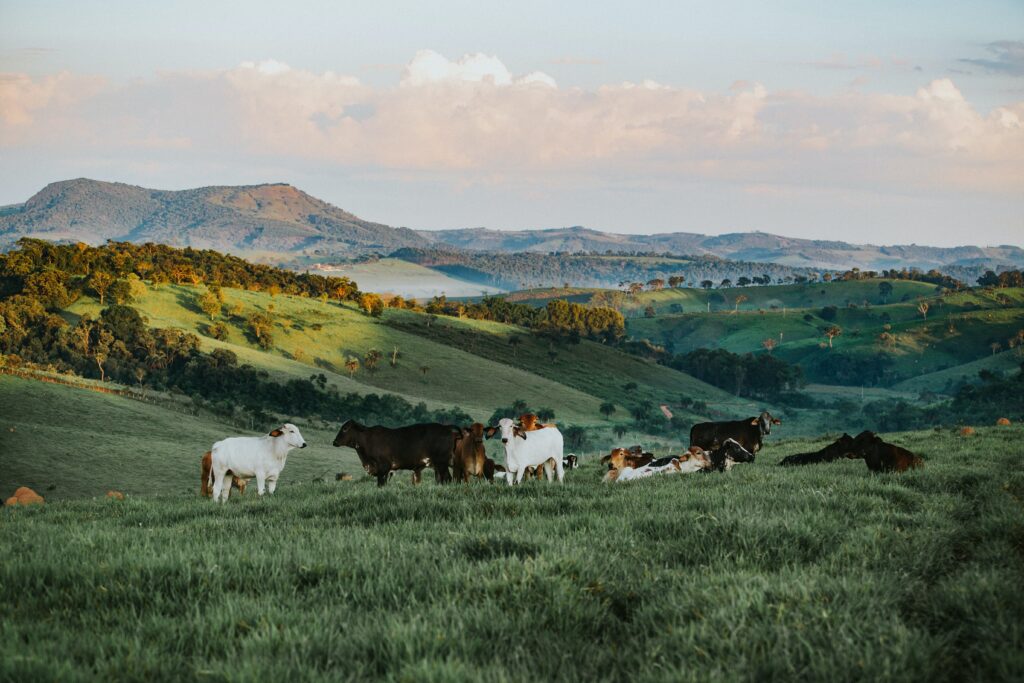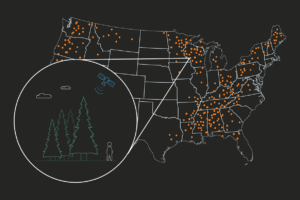
Are you a farmer or rancher? Own open, arable land? NCX can help you create additional revenue streams from your land through the many natural capital programs offered on our marketplace.
Although forest carbon credits get a lot of attention, there are many natural capital programs for non-forested areas like pasture, range, and agricultural land. In this post, we’ll cover four popular types of programs that your land might be eligible for: regenerative agriculture, solar energy, agroforestry, and afforestation.
Regenerative Agriculture
Eligible land types: agricultural, grassland
Regenerative agriculture practices improve soil health, restore biodiversity, and increase ecosystem resilience. Common types of regenerative agriculture practices include:
- Rotational grazing
- Restoring native grasses
- Mitigating soil erosion
- Improving water runoff quality
- Converting cropland to native pasture
- Reducing synthetic fertilizer and pesticide use
If you are a rancher or farmer, you may be eligible for regenerative agriculture programs on NCX. Some programs require thousands of acres, while others can scale down to 50 acres. These programs typically involve the adoption of new land management practices and ongoing soil sampling and other monitoring to quantify the ecological impact.
In addition to the ecological benefits, these programs can provide an additional revenue stream for your land. Your regenerative agriculture practices can generate carbon credits that the program partner markets and sells. You may receive annual payments or a revenue share from the sale of these credits.
Solar
Eligible land types: agricultural, grassland, arid lands
Thanks to state and federal regulations and tax incentives such as the Investment Tax Credit, there are many new solar programs available for rural landowners. One common type of solar program is called “community solar.” Much like a community garden where a neighborhood all grows vegetables in a central, suitable area, community solar allows for clean energy to be generated in one central location. You host the site while the solar company builds and operates the solar installation. You receive ongoing payments while your neighbors reap the benefits of cheaper, cleaner electricity.
Your eligibility for community solar is determined by factors such as local electricity demand and proximity to power lines. You’ll also need enough open space – most installations need at least 10 acres.
A typical community solar project has three main steps:
- Development – Remote and on-site assessments to determine the site feasibility. After approval by the local electrical utility and land use body, construction begins.
- Operation – The solar installation begins producing power
- Decommissioning – Once the contract period is over, you may have the option to renew the contract. If you’d like the land restored to its original state, the solar company is required to fully decommission the site and restore the land to the best of their ability. Many have a “leave no trace” policy.
The solar company typically covers all associated costs from each phase, so you usually won’t pay any money out of pocket. You’ll also typically receive payments throughout each of the various phases of the project.
In the development phase, the solar company will typically pay you a fee for the option to develop a solar project on your land. Since certain approvals by entities like the local utility are needed for the site to become operational, the solar company reserves the bulk of the payments until the approvals come through and the site is operational.
Once the project is generating electricity, you’ll receive significant lease payments for each year the site produces electricity until the end of the contract.
Some solar companies also offer additional incentives such as bonuses for the inconvenience of construction or payments to account for increased property taxes.
Tree Planting: Agroforestry and Silvopasture
Eligible land types: agricultural, grassland
If you are a farmer or rancher, you may be able to generate financial and ecological benefits through the agroforestry and silvopasture programs available through NCX. This broad category of programs includes many different options for integrating trees with your ongoing farming and ranching operations. Because of the upfront costs, agroforestry practices have not been widely adopted across the US. The programs available on NCX can help reduce or eliminate those upfront costs, helping you create a new revenue stream for your property.
Some examples of agroforestry or silvopasture practices are:
- Planting trees among existing field crops or on grazing land
- Planting trees around field perimeters and at waterfronts
There are many benefits to these practices, including improving soil health and water retention, increased crop yields, and reduced heat stress for livestock. Depending on the trees you plant, you may also be able to harvest timber, nuts, and fruit.
Government, nonprofit, and commercial agroforestry/silvopasture programs are available through NCX. The payment terms vary from cost shares and yearly rental payments (through the USDA’s CRP or EQIP programs) to per-tree upfront “installation payments” to defray planting costs. Alternatively, some programs offer a revenue share for any carbon credits generated from the trees you plant – with prices up to $90/acre.
Tree Planting: Afforestation, Reforestation, and Revegetation
Eligible land types: grassland, previously forested land, marginal agricultural land
Last, but not least, you can consider planting trees on your open land if the ecological conditions are appropriate. A healthy forest can provide not only timber and carbon sequestration, but can also help boost biodiversity in some ecosystems.
Through the Afforestation, Reforestation, and Revegetation (ARR) programs available on NCX, you may be able to defray some or all of the cost of tree planting and/or receive ongoing payments for carbon credits that your trees generate. Some ARR programs focus on converting pasture to forests, or on restoring previously forested land that experienced a severe fire or pest outbreak. Other programs are open to any suitable land with the right soil type and precipitation conditions.
The general steps in a tree planting project are:
- Site Preparation
- Seedling Procurement
- Planting Crew Contracting
- Planting Operations
- Ongoing Care and Maintenance
Typically, you’ll work with a forester to coordinate and oversee this work. If you don’t already work with a forester, you can find one through NCX. Alternatively, some programs available through NCX will handle all of the planting operations for you.
Financial terms for these programs vary, but many offer either annual payments or a revenue share from carbon credit sales. Many of these programs cover all planting costs and management activities. One program even allows the landowners to harvest the resulting timber in addition to getting a carbon payment while the trees grow.
Avoided Conversion / Conservation Easements
Eligible land types: agricultural, grassland
Some programs will compensate you for keeping your land in its current agricultural use and not converting it into some other land use like a subdivision, shopping mall, etc. There are also programs for avoiding conversion of native grasslands into row crops.
The foundation of many of these programs is a conservation easement – a legal agreement to preserve your land, often in perpetuity. Typically the counterparty of these legal agreements is a local land trust or a government agency.
Compensation for these programs can come in several forms. There are typically tax benefits of enrolling your land in a conservation easement. Some programs will cover a portion of your legal fees for creating and maintaining your easement agreement. And some programs bundle conservation easements with carbon programs and offer a share of the carbon revenue.
Find the Right Program for Your Land
Ready to learn more? Create a free account at NCX.com and see which programs your land is eligible for.



